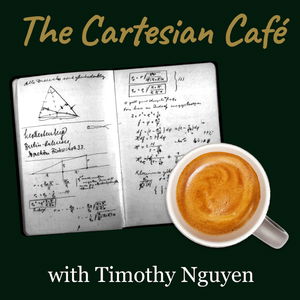Sean Carroll is a theoretical physicist and philosopher who specializes in quantum mechanics, cosmology, and the philosophy of science. He is the Homewood Professor of Natural Philosophy at Johns Hopkins University and an external professor at the Sante Fe Institute. Sean has contributed prolifically to the public understanding of science through a variety of mediums: as an author of several physics books including Something Deeply Hidden and The Biggest Ideas in the Universe, as a public speaker and debater on a wide variety of scientific and philosophical subjects, and also as a host of his podcast Mindscape which covers topics spanning science, society, philosophy, culture, and the arts.
www.patreon.com/timothynguyen
In this episode, we take a deep dive into The Many Worlds (Everettian) Interpretation of quantum mechanics. While there are many philosophical discussions of the Many Worlds Interpretation available, ours marries philosophy with the technical, mathematical details. As a bonus, the whole gamut of topics from philosophy and physics arise, including the nature of reality, emergence, Bohmian mechanics, Bell's Theorem, and more. We conclude with some analysis of Sean's speculative work on the concept of emergent spacetime, a viewpoint which naturally arises from Many Worlds. This video is most suitable for those with a basic technical understanding of quantum mechanics.
Part I: Introduction
00:05:42 : Philosophy and science: more interdisciplinary work?
00:09:14 : How Sean got interested in Many Worlds (MW)
00:13:04 : Technical outline
Part II: Quantum Mechanics in a Nutshell
- 00:14:58 : Textbook QM review
00:24:25 : The measurement problem
00:25:28 : Einstein: "God does not play dice"
00:27:49 : The reality problem
Part III: Many Worlds
- 00:31:53 : How MW comes in
00:34:28 : EPR paradox (original formulation)
00:40:58 : Simpler to work with spin
00:42:03 : Spin entanglement
00:44:46 : Decoherence
00:49:16 : System, observer, environment clarification for decoherence
00:53:54 : Density matrix perspective (sketch)
00:56:21 : Deriving the Born rule
00:59:09 : Everett: right answer, wrong reason. The easy and hard part of Born's rule.
01:03:33 : Self-locating uncertainty: which world am I in?
01:04:59 : Two arguments for Born rule credences
01:11:28 : Observer-system split: pointer-state problem
01:13:11 : Schrodinger's cat and decoherence
01:18:21 : Consciousness and perception
01:21:12 : Emergence and MW
01:28:06 : Sorites Paradox and are there infinitely many worlds
01:32:50 : Bad objection to MW: "It's not falsifiable."
Part IV: Additional Topics
- 01:35:13 : Bohmian mechanics
01:40:29 : Bell's Theorem. What the Nobel Prize committee got wrong
01:41:56 : David Deutsch on Bohmian mechanics
01:46:39 : Quantum mereology
01:49:09 : Path integral and double slit: virtual and distinct worlds
Part V. Emergent Spacetime
02:02:42 : Algebraic geometry / functional analysis perspective
02:04:54 : Relation to MW
Part VI. Conclusion
- 02:07:16 : Distribution of QM beliefs
02:08:38 : Locality
Further reading:
- Hugh Everett. The Theory of the Universal Wave Function, 1956.
Sean Carroll. Something Deeply Hidden, 2019.
More Sean Carroll & Timothy Nguyen:
Fragments of the IDW: Joe Rogan, Sam Harris, Eric Weinstein: https://youtu.be/jM2FQrRYyas
Twitter: @iamtimnguyen
Webpage: http://www.timothynguyen.org
